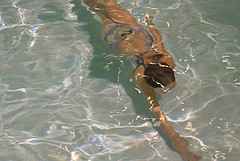As softball coaches, we sometimes experience difficulty in finding practice sites and times. Would you believe that there is a facility on most campuses and in most communities that can be used in lieu of a field, and goes virtually unused by most softball teams? That facility is the swimming pool, where there is usually ample free time to give you convenient practice scheduling for hydro-resistance softball training.

Not just for swimming, the pool has long provided a valuable facility for sports injury rehabilitation. When used in conjunction with your training program, it can allow injured athletes to rehabilitate and still participate in practice and they can feel like a part of the team.
To date, the benefit of the hydro-resistance training is largely overlooked for non-injured athletes. This type of softball training increases the players’ range of motion and flexibility, bat speed, leg power, and endurance. Plus, athletes suffer fewer injuries in the pool and can experience more fun at regular practices because of the variety in the training program.
In addition, hydro-resistance training provides:
- Resistance by water which provides the conditions for work out with little or no risk of injury. Athletes will push themselves harder and harder in each practice session.
- Slow-motion evaluation of the players’ fielding and batting habits. Coaches can immediately critique and correct bad habits.
- Whole body conditioning, including increasing lung capacity, stamina and overall endurance.
Here is an example program designed to add to the development on the field:
Segment 1: Stretch and Flex – The athletes choose their five favorite exercises for shoulders, quadriceps, hamstrings, ankles and back (one of each type).
Segment 2: Chest-Deep Run – Players simulate stealing a base by running from one side of the pool to the other in chest-deep water. Then repeat the exercise running backwards. This helps to evaluate running styles.
Segment 3: Bat Swing – By swinging an aluminum bat under the water, we evaluate swinging technique and work to correct any imperfections.
Segment 4: Relays and Lap – Used to increase strength and competitive spirit, this provides a good work out for endurance. Lap swimming of increasing lengths is part of the program.
Segment 5: Cool Down – Stretching exercises to some relaxing music allows athletes to ease out of the training session.
We have found that this program promotes team unity and spirit through competition, in addition to increasing endurance and stamina. The players are more excited about practice because an element of fun has been put back into a sometime monotonous routine.